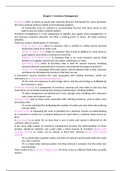Resume
Samenvatting External Environment Chapter 7
- Cours
- Établissement
Summary of chapter 7: Inventory Management Thaught at Rotterdam Business School, International Business, 1st year. Course: Operations & Supply Chain Management. Publisher: Pearson
[Montrer plus]



